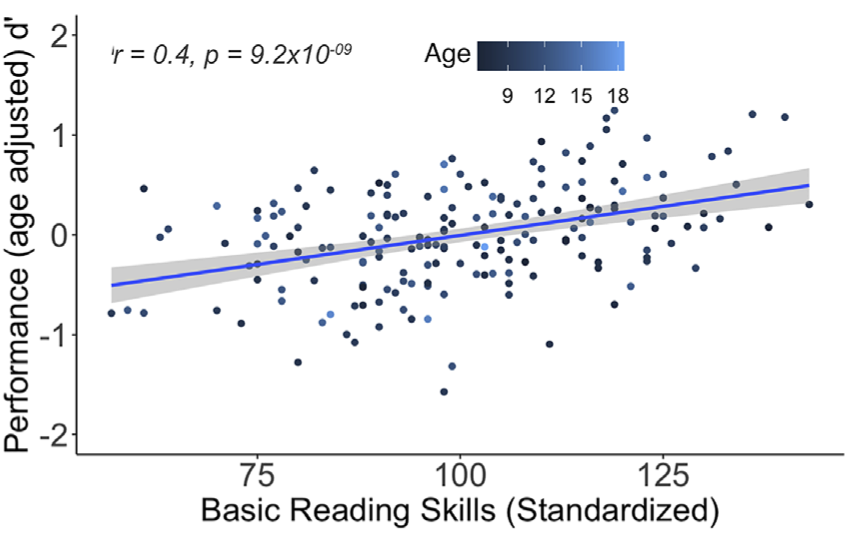31 Predictive validity of ROAR-RVP
31.1 Background: Published studies
The correlation between rapid visual processing and reading outcomes were first reported in a large cross-sectional sample by (Ramamurthy, White, and Yeatman 2024). Reading challenges are not primarily an issue with visual processing, though there is strong evidence that visual processing differences contribute to and/or exacerbate reading difficulties. Figure 31.1 shows published findings from Ramamurthy, White, and Yeatman (2024) demonstrating the relationship between RVP and reading ability is participants ages 6-18.
31.2 Correlating Reading Outcomes with Concurrent RVP Measures
In the calibration sample of n=175 kindergarten and first grade children (see Section 19.2.2.4) we replicated the correlation strength reported in the cross-sectional sample in the calibration cohort of kindergarten and first grade children (Ramamurthy et al., n.d.). Figure 31.2 shows the correlation between task performance in the Rapid Visual Processing and various reading outcomes.
31.3 Winter to spring predictions: RVP measured in the winter predicts end of year reading scores
In Winter 2023, 755 participants completed the RVP tasks and in Spring 2023 these students were administered Kaufman Test of Educational Achievement (KTEA) reading composite measure. The correlation strength between KTEA and task performance, in both the Letter (RVPL) [r = 0.42, p < 2.2x10-16; CI: 0.359 - 0.477] and pseudo-letter (RVPS) [r = 0.37, p < 2.2x10-16; CI: 0.307 - 0.431] versions were similar [∆r: 0.0489; z = 1.9166, p = 0.0553; computed using the cocor package in R (Diedenhofen and Musch 2015) that uses Hittner, May, and Silver’s (2003) modification of Dunn and Clark’s z (1969) using a back transformed average Fisher’s (1921) Z procedure]. Figure 31.3 shows the predictions of end of year reading scores. The correlation strengths were also comparable to our calibration data set and the previous cross-sectional study reported above in Figure 31.2.
A regression model with both letter and pseudo-letter scores predicted KTEA better than either measure on its own [Model A. Performance in the RVPL task explained 17.5% of variance in KTEA composite scores; Model B. performance in the RVPS task explained 13.7% of variance in KTEA composite scores; and Model C. with both RVPL and RVPS (KTEA ~ letters + pseudo-letters) as predictors explained 18.6% of variance in KTEA composite scores. Model C is significantly better than either models: Models A vs C: F(1,752) = 10.609; p = 0.001; and Models B vs C: F(1,752) = 46.373, p = 2.002x10-11].


